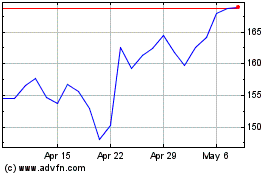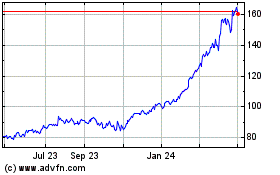The World Has Too Many Jet Engines -- Heard on the Street
August 03 2020 - 8:22AM
Dow Jones News
By Jon Sindreu
A "V-shaped" recovery is looking even more unlikely for
aircraft-engine makers than for the global economy.
Last week, General Electric and Raytheon Technologies reported
steep losses in their aerospace divisions. In normal times these
make up roughly 70% and 80% of the conglomerates' operating
earnings, respectively.
Airlines have been hit harder by Covid-19 than plane makers
Boeing and Airbus, which have more robust balance sheets. But parts
manufacturers that rely on the maintenance, repair and overhaul of
aircraft have historically had even more volatile revenues than
carriers.
Key among these suppliers are makers of engines -- the most
technologically complex part of the aircraft. They have embraced
this so-called aftermarket, often selling their products at a loss
and slowly clawing back the money by servicing them. In the second
quarter, aftermarket revenues for General Electric Aviation and
Raytheon's Pratt & Whitney, the two top American jet-engine
makers, dropped 67% and 51% year over year, respectively.
These figures, though horrid, came in better than expected,
given that air traffic globally was down 80% from a year ago in
June, according to the International Air Transport Association.
Raytheon Chief Executive Greg Hayes told analysts that he believed
the second quarter would be the trough.
With a lag of roughly three months, aftermarket business has
usually rebounded strongly after precipitous falls, leading to
bouts of outperformance for the shares of engine manufacturers over
those of Boeing and Airbus.
But this time could be different.
In this highly unusual crisis, airlines have been forced to keep
some routes active in exchange for government aid. The number of
planes in the sky, which is what matters for the maintenance
business, has fallen less than passenger numbers.
Another factor has been the growth of "power by the hour"
contracts, which spread maintenance payments depending on engine
use. Traditional contracts involving lump sums incentivized
carriers to stop going to the shop during downturns, only to return
all at once as the outlook improved. Yet lower volatility will also
mean less upside later on.
Above all, investors may still be underestimating the sheer
severity of the current downturn and its impact on the global
fleet.
The retirement of older models like the era-defining Boeing 747
or many jets of the Airbus A330 family, as happened after previous
aviation downturns, wouldn't be a surprise. This puts Britain's
engine specialist Rolls-Royce, which is focused on large planes, at
a particular disadvantage.
Yet younger, more popular models might not escape unscathed.
Even some previous-generation Airbus A320s and Boeing 737s serviced
by both GE and Pratt, which are the backbone of the global
narrow-body fleet, could stay parked. This would further reduce the
potential installed base of jets in need of repairs, and create an
oversupply of engines that, while older, still have "green time"
left in them -- meaning they can be swapped in to replace any that
would otherwise need maintenance.
Robert Spingarn, Credit Suisse's aerospace analyst, estimates
that, while the total active plane fleet will decline 37% in 2020,
jets out of warranty will fall by 58%. Looking at the engines that
power the older generation of A320 and 737 aircraft, about 70% of
the fleet that was flying at the end of 2019 could be brought back
using only engines that won't need overhauls until 2023 or
later.
"The depression is so deep that if we have a more permanent
shrinkage of the fleet, maybe that wave of overhauls doesn't
eventually come," he said.
Rather than expecting the traditional aftermarket rebound,
investors should brace for potential mergers, and even a rethinking
of the industry business model. For engine makers, this is no
ordinary downturn.
Write to Jon Sindreu at jon.sindreu@wsj.com
(END) Dow Jones Newswires
August 03, 2020 08:07 ET (12:07 GMT)
Copyright (c) 2020 Dow Jones & Company, Inc.
GE Aerospace (NYSE:GE)
Historical Stock Chart
From Mar 2024 to Apr 2024

GE Aerospace (NYSE:GE)
Historical Stock Chart
From Apr 2023 to Apr 2024
